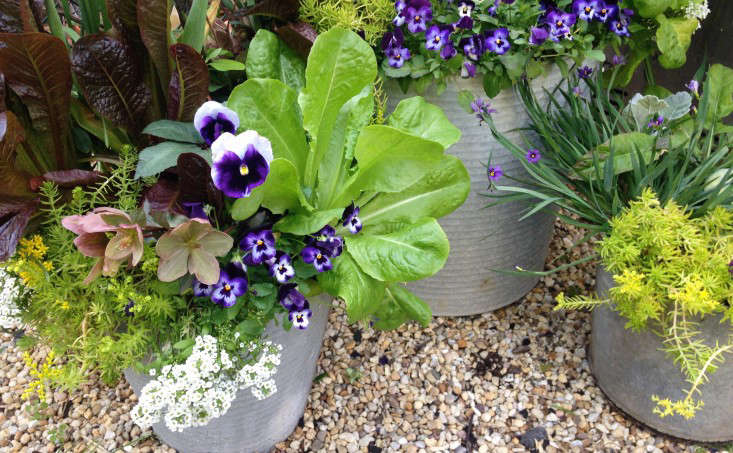I’m a container garden designer based in Annapolis, Maryland, and I notice that in springtime many gardeners skip container gardening because they’re more focused on flowering bulbs in the ground and budding trees overhead. This is a mistake. With a little creativity, you can create spring container gardens that will last into summer.
The secret? Expand your plant palette. Instead of limiting yourself to seasonal annuals, incorporate perennials and edibles into spring container designs and they will provide a rewarding show for seasons to follow. Here’s how, with a few photos of my Field + Canvas container gardens for spring:
Photography courtesy of Field + Canvas.
The Basics
Above: In container design there are three basic elements: tall, thick, and trailing. For many, the tall and trailing plants are simple to identify and utilize, but the thick fillers make for a challenge. Thick fillers are often foliage plants that give texture and supporting weight to the tall and trailing elements. It is during the spring months though that many of these foliage plants produce their small blooms, giving more reason to incorporate them into your designs earlier.
Edibles and Herbs
Above: Edibles and herbs are a good option for your filler element providing texture and brilliant color as well as taste to your foods. In the spring particularly, your cool season lettuces, cabbage, kale, and Swiss chard can easily be mixed in next to the seasonal pansies and violets for complimentary proportions. Hardy herbs such as parsley, rosemary, and sorrel can add their very own unexpected texture among the broadleaf plants in a container design. There is no reason to keep your herbs and vegetables separate from your ornamentals especially in spring.
Perennials
Above: There are a few go-to perennial examples to consider for spring. Hellebores with their nearly evergreen foliage and rose like flower range in bloom color from white to pale green and mauve to a deep purple.The perennials Hellebore and Lucerne Blue Eyed Grass are in full spring bloom here and will persist to offer their unique foliage and texture summer into fall.
Bergenia, Brunnera, Euphorbia, Lady’s Mantle, Lambs Ear, hardy ferns, and small grasses are others to consider for spring to fall interest.
Shrubs
Above: When it comes to choosing a tall plant for your container, a spring blooming shrub that emulates the blossoming landscape in the background will provide multiple seasonal interest. Shown here a Rhododendron about to reveal its showy pink blooms will persist well into the winter months with its evergreen foliage. Other early blooming shrubs to try this spring include Azaela, Fothergilla, Hydrangea, Laurel, Loropetalum, and Viburnum. Keep in mind once these outgrow your container, you can always transplant them out into the landscape come fall.
Annuals
With annuals, container gardens have the ability to provide instant impact while the rest of the landscape grows at a slower natural rate. In this spring container pansies provide the seasonal color contrasting with the lush broad leaves of red and green romaine lettuce and the delicate white flowers of sweet alyssum. For another punch of spring green, Sedum rupestre ‘Angelina’ will then also turn a brilliant orange come fall. Ajuga, Lysimachia creeping jenny, and creeping wire vine are three more wonderful unique trailing plants whose foliage stuns spring through fall.
By incorporating more variety into your spring container designs utilizing perennials, edibles, and evergreens alongside annuals they do not have to be completely uprooted each season. You can still make the most out of each season with a packed full container just by swapping out the seasonal color annuals and leaving the mature perennials to continue persisting as the texture and structure for your design.

















Have a Question or Comment About This Post?
Join the conversation (0)